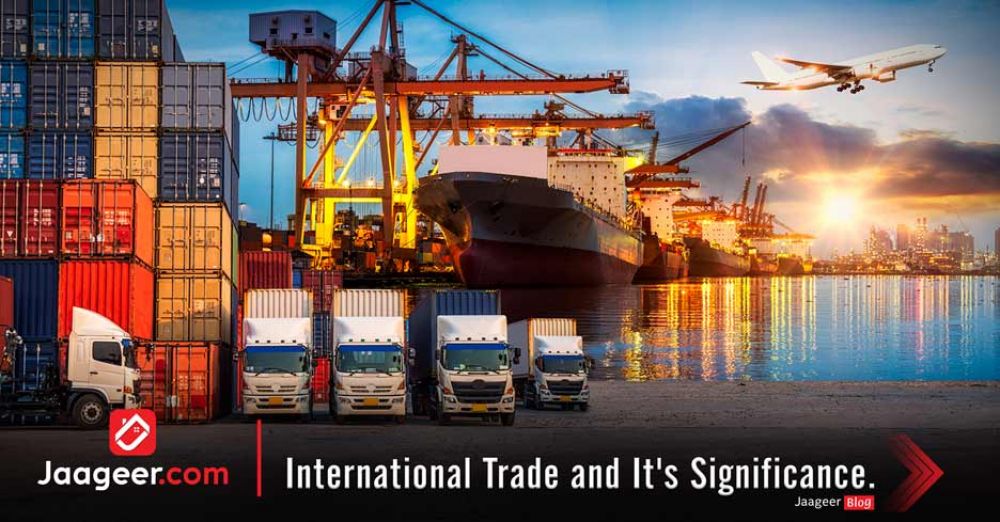Among all the companies of a rustic, trading is that the first and foremost factor that predicts the longer term of a country's economy. It is the backbone of the economy and the economy is the backbone of a country. The extensive trade, the illustrious are going to be the economy of a rustic. International trade is the exchange of goods and services amongst countries. International trading has always been crucial in improving living standards, providing better opportunities, and allowing consumers to fulfill and enjoy an exceptional lifestyle and variation of goods. For this very reason, foreign trade is one of the key paths for countries to enjoy a myriad of fresh produce, e.g., Pakistani mangoes in the United Kingdom (UK) and China. The World Bank statistics reports show that world exports of GDP have raised from 12% in 1960 to approximately 30% in 2015.
Types of International Trade:There are two types of international trade:
Export Trade Import TradeExport trade is when an honest is produced in one country and is sold and shipped to a different country. Import Trade, on the contrary, refers to the great purchased into one country from another country. Entrepot trade may be a combination of the previously explained trading. This flow of exports and imports is what determines the balance of payments.
Benefits of Trading:
Comparative AdvantageThe comparative advantage is a theory that states that the countries must specialize in those goods where they have a lower opportunity cost. If one country can produce two goods at a lower cost, it doesn’t imply that they will or should produce everything. Pakistan, having lower labor costs may possess the comparative advantage in labor-intensive production, clothing manufacture, call centers, etc. Thus, it would be wise for Pakistan to export these goods and services.
Raw Material leading CountriesMany countries have natural raw materials like oil from Saudi Arabia and Iran, coal, timber, nickel from Australia, lead and chromium from China, etc, these countries won’t enjoy the natural endowments of raw material. Eli Heckscher and Bartle Ohlin is understood because the Heckscher-Ohlin (H-O model). The model stated that countries naturally abundant in raw materials should concentrate on producing exporting goods. Countries will import such goods where resources are rare and limited.
Competition factorCompetition factor arises due to the trading process. It is beneficial for local suppliers and consumers. The suppliers got to make certain that their prices are market competitive to satisfy the foreign competition.
Economies of scaleAs a country expands its production to export, its innovative measures allow it to achieve greater efficiency that enables economies of scale. Economies of scale may be a phenomenon that happens when a corporation increases the size of production or output, via increased efficiency, leading to decreased costs. When a country experiences economies of scale, it means it’s able to manufacture products or offer services efficiently and can explore new markets for expanding its export base. In this way, exports become cost-effective for the producing country.
Employment Opportunities:Under international trade, employment greatly increases. An important example of this can be Pakistan under the CPEC which has positively contributed to Pakistan’s employment numbers. An increase in international trade creates several job opportunities in both countries. That’s one reason why significant countries such as Japan, the US, Canada, and South Korea have lower unemployment rates. Trade demands countries and nations to produce goods and services modernized yet cheap. This is because with the greater exchange of investment and expertise there's a greater chance of newer industries being found out which ultimately boosts local businesses. In this case, more jobs are created and more people are hired.
Pakistan Trade System:Pakistan’s economy is largely dependent on the agriculture sector; therefore its major exports are agricultural products, which include wheat, rice, vegetables and fruits, and pulses. International trade in Pakistan, therefore, comprises exports of agricultural products, and imports of machinery and finished products. Being a serious cotton producer, Pakistan exported USD 2.64 billion worth of cotton and cotton products throughout the planet during the financial year 2020-2021. Recently, Pakistan witnessed magnificent growth in exports to China, Germany, Netherlands, and Poland. These are promising figures for Pakistan as they signal economic activity during the pandemic, especially as much of the global economy has been considered in a recession period. This is primarily thanks to the economic base expansion under CPEC which has not only created job opportunities but also introduced modern production methods to maximize output.In Covid Scenario Pakistan has also worked on health machinery and has manufactured its own ventilators, improving the quality are thought to exports machinery items to other countries increasing the trade surplus in future. In the coming years, it's expected that Pakistan will emerge as a top destination for many of the South Asian region’s agricultural produce, and IT-based services.
We should involve ourselves in world economic activities that allow consumers to use goods and services at their best outcomes. It is an important factor of every country participating in the exchange system of goods or services on sovereign grounds. Countries need interaction with one another to be recognized by the international community. Thus, trading is peaceful thanks to doing this. International trade strengthens the relationship with other countries and can play a vital role to stand as a staunch supporter besides them in time of need.








